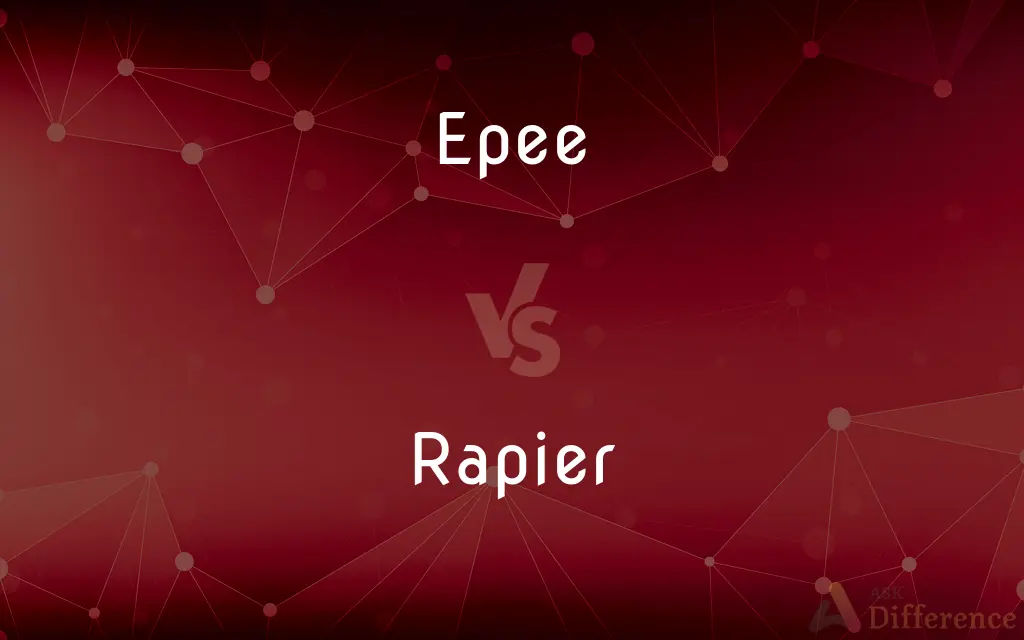Epee vs. Rapier — What's the Difference?
By Urooj Arif & Maham Liaqat — Updated on March 17, 2024
The epee is a thrusting weapon used in modern fencing, while the rapier is a historical sword optimized for both thrusting and cutting.

Difference Between Epee and Rapier
Table of Contents
ADVERTISEMENT
Key Differences
The epee is a modern fencing weapon, characterized by its rigid, triangular blade, designed primarily for thrusting. It is one of the three weapons used in the sport of fencing, with a large hand guard and a blunt tip, often equipped with a button to register touches electronically in competitions. In contrast, the rapier is a historical sword that was popular in Europe during the 16th and 17th centuries, known for its long, narrow blade and elaborate hilt, designed to protect the hand during duels.
While the epee is used exclusively in the sport of fencing and follows specific rules that allow for hits to be scored by striking any part of the opponent's body, the rapier was a weapon of self-defense and dueling. The rapier's design allows for both thrusting attacks and, to a lesser extent, cutting strikes, making it a versatile weapon in combat.
The rules of engagement differ significantly between the two. Epee fencing is governed by rules that include right of way and electronic scoring systems to determine valid hits. The rapier, used in historical combat and dueling contexts, followed the conventions and etiquette of the time, with duels often fought to first blood or until a serious injury occurred, governed by a code of honor rather than a formalized set of rules.
In terms of construction, the epee's blade is heavier and wider than that of a foil (another fencing weapon), making it more similar to the rapier in terms of weight. However, the rapier's blade is typically longer and designed for both cut and thrust, whereas the epee is strictly a thrusting weapon.
Understanding the historical context and the evolution of swordsmanship can provide insight into the differences between the epee and the rapier. The epee's design and use in modern fencing can be seen as a continuation of the art of swordsmanship, adapted to a sportive context, while the rapier remains a symbol of the martial traditions of Renaissance Europe.
ADVERTISEMENT
Comparison Chart
Type
Modern fencing weapon
Historical sword
Use
Sport fencing, thrusting
Dueling, self-defense, thrusting and cutting
Blade
Rigid, triangular, blunt tip
Long, narrow, sharp
Rules
Electronic scoring, hit any body part
Historical dueling conventions
Design
Large hand guard, button for scoring
Elaborate hilt for hand protection
Compare with Definitions
Epee
A thrusting weapon used in modern fencing with a rigid, triangular blade.
He scored the winning touch with his epee in the final bout.
Rapier
A historical sword optimized for thrusting and cutting, popular in the 16th and 17th centuries.
The rapier was a favored weapon among duelists for its elegance and effectiveness.
Epee
Features a large hand guard and a blunt tip with a button.
The epee's hand guard provided ample protection during the match.
Rapier
Known for its long, narrow blade and elaborate hilt.
The rapier's elaborate hilt was as much a work of art as it was a functional protection.
Epee
Designed for precision and control in sportive contexts.
Mastering the epee requires a focus on timing and distance.
Rapier
Symbolizes the martial traditions of Renaissance Europe.
The rapier is often associated with the swashbuckling heroes of Renaissance literature.
Epee
Allows hits on any part of the opponent's body.
The fencer exploited the epee's rule, scoring a touch on the opponent's foot.
Rapier
Allows for versatile combat techniques, including cuts.
Unlike the epee, the rapier was adept at both thrusting and delivering slicing cuts.
Epee
Used in competitions with electronic scoring systems.
The electronic scoring system registered his epee touch accurately.
Rapier
Used in self-defense and dueling, following a code of honor.
Duelists chose the rapier for its balance of reach and agility.
Epee
(fencing) A sharp-pointed dueling sword with a bell-shaped guard, used (with the end blunted) in sport fencing.
Rapier
A long, slender, two-edged sword with a cuplike hilt, used in the 1500s and 1600s.
Epee
A fencing sword similar to a foil but with a heavier blade
Rapier
A rapier () or espada ropera is a type of sword with a slender and sharply-pointed two-edged blade that was popular in Western Europe, both for civilian use (dueling and self-defense) and as a military side arm, throughout the 16th and 17th centuries. Important sources for rapier fencing include the Italian Bolognese group, with early representatives such as Antonio Manciolino and Achille Marozzo publishing in the 1530s, and reaching the peak of its popularity with writers of the early 1600s (Salvator Fabris, Ridolfo Capo Ferro).
Epee
A fencing sword with a bowl-shaped guard and a long, narrow, fluted blade that has no cutting edge and tapers to a blunted point.
Rapier
A light, sharp-pointed sword lacking a cutting edge and used only for thrusting.
Epee
The art or sport of fencing with this sword.
Rapier
A slender, straight, sharply pointed sword (double-edged, single-edged or edgeless).
Rapier
Extremely sharp.
Rapier
Cutting; employing keen wit.
John is very quick on his feet during interviews by using his rapier responses.
Rapier
A straight sword, with a narrow and finely pointed blade, used only for thrusting.
Rapier
A straight sword with a narrow blade and two edges
Common Curiosities
How do the rules of engagement differ between epee fencing and rapier dueling?
Epee fencing has structured rules with electronic scoring, whereas rapier dueling followed historical conventions without electronic aids.
Can the epee be used for cutting?
No, the epee is strictly a thrusting weapon, with a design that does not facilitate cutting.
Is the epee's hand guard similar to the rapier's hilt?
Both provide hand protection, but the rapier's hilt is more elaborate, designed for both protection and aesthetic appeal.
How has epee fencing evolved?
Modern epee fencing has evolved with technological advancements like electronic scoring, but it retains the fundamental principles of classical fencing.
Can women compete in epee fencing?
Yes, epee fencing is an inclusive sport with categories for men, women, and mixed teams in competitions.
Was the rapier used in formal duels?
Yes, the rapier was a popular choice for duels and self-defense in the 16th and 17th centuries, guided by a code of honor.
Why is the epee used in modern fencing?
The epee continues the tradition of swordsmanship in a sportive context, emphasizing precision, timing, and strategy.
How do fencing competitions handle epee bouts?
Epee bouts in competitions are managed with precise rules, electronic scoring, and referees to ensure fairness and safety.
What distinguishes an epee from a rapier?
The epee is a modern fencing weapon designed for thrusting, while the rapier is a historical sword used for both thrusting and cutting.
What role did the rapier play in Renaissance society?
The rapier was not only a weapon but also a symbol of social status and personal skill in Renaissance Europe.
What is the significance of the rapier's elaborate hilt design?
The hilt not only provided protection for the hand but also reflected the personal style and status of the wielder.
Are there different styles of rapiers?
Yes, the design of rapiers varied over time and across regions, reflecting different schools of fencing and aesthetic preferences.
Do historical reenactors use rapiers?
Yes, historical reenactors and martial artists study and use rapiers to understand and preserve historical fencing techniques.
Was the rapier effective in historical battles?
The rapier was more suited to personal defense and duels than to battlefield combat, where heavier weapons were typically used.
What materials are modern epees made from?
Modern epees are typically made from high-grade steel for the blade and durable materials for the guard and grip, ensuring safety and longevity in the sport.
Share Your Discovery

Previous Comparison
Competition vs. Cooperation
Next Comparison
Nanny vs. MaidAuthor Spotlight
Written by
Urooj ArifUrooj is a skilled content writer at Ask Difference, known for her exceptional ability to simplify complex topics into engaging and informative content. With a passion for research and a flair for clear, concise writing, she consistently delivers articles that resonate with our diverse audience.
Co-written by
Maham Liaqat













































